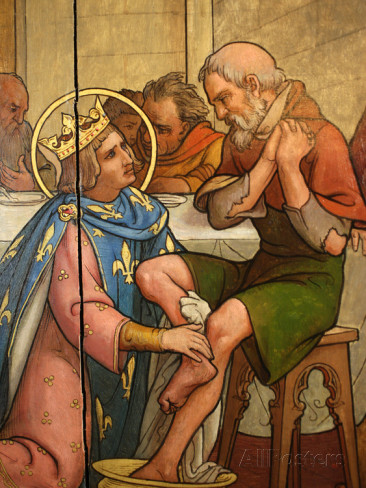Maundy Thursday in History and in my Books . . .
Today is Maundy Thursday. The final Thursday before Easter, Maundy Thursday commemorates the Last Supper—the event which established the Holy Eucharist. Historically Maundy Thursday is associated with powerful figures washing the feet of the marginalized (a King might wash the feet of a pauper—see the stained-glass depiction below—and this year Pope Francis will wash the feet of a dozen refugees) as Jesus washed the feet of his disciples. Evidence of the rite of Pedilavium (the Church’s term for this ceremonial foot washing) goes back to very ancient times and is considered a joyous rather than a solemn ceremony. The word “Maundy” comes from Latin for “command” and refers to Christ’s commandment to his disciples to “love one another as I have loved you.” 
I cannot say when or why exactly I became slightly fixated on this particular religious observance, but Maundy Thursday makes multiple appearances in my work. It was included in the original draft of The Sister Queens (Louis, seen at the right, was a hugely penitent man who not only frequently washed the feet of the less fortunate but liked to eat the leftovers of meals consumed by his favorite leper). King Charles IX and Queen Catherine de Médicis observe the Lenten foot-washing tradition in Chapter 2 of Médicis Daughter. An occasion that finds a teenage Margot in no very good mood:
“Why do you pout?” My brother sidles up to me where I stand, watching Charles and Mother receive basins and ewers from the Cardinal de Bourbon. Nearby, a collection of Troyes’s paupers—mostly women and children—sit on a long bench, prepared to be the objects of royal Lenten piety.
“I did not realize I would be left out of some of the grandest ceremonies of the journey.”
Yesterday the King made a magnificent Entry into Troyes—riding beneath a canopy supported by dignitaries past elaborate set pieces and stopping to hear recitations of poetry written for the occasion. The residents of the city, from the wealthiest to the urchins roaming its streets, were permitted to witness it all. I was not. It seems the women of the court, even the Valois women, are not included in the proceedings that constitute a Royal Entry.
As for What’s Next . . . I can tell you this, Chapter 4 of my latest novel begins with a mumbled, “Last Supper” and Maundy Thursday marks some very dramatic events.